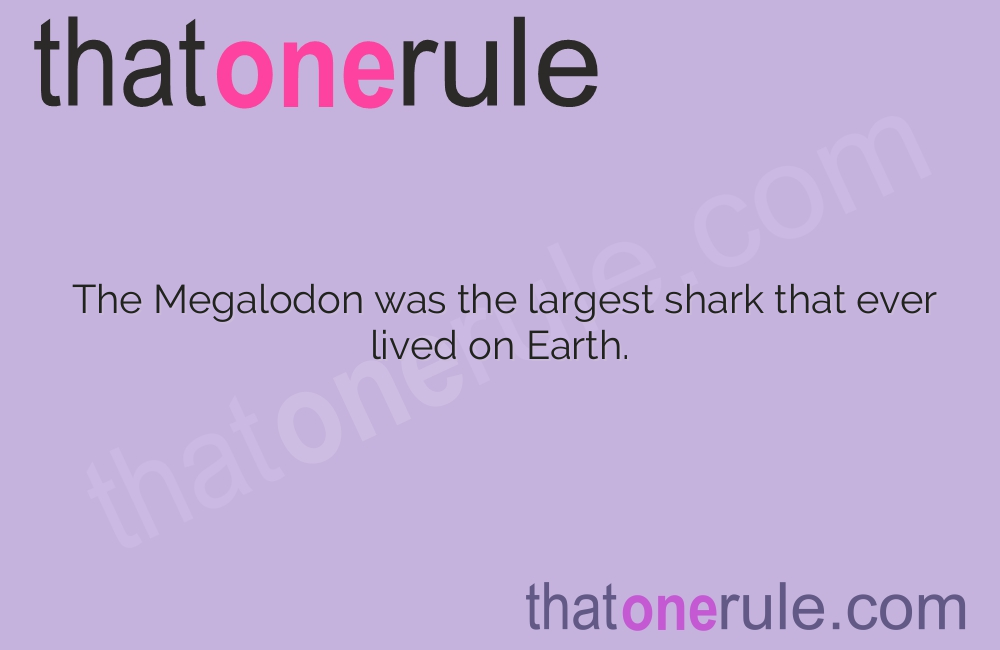

The Megalodon was the largest shark that ever lived on Earth.
The Megalodon was the largest shark that ever lived on Earth.
Megalodon’s teeth could reach up to 7 inches in length.
This prehistoric shark existed over 23 million years ago.
The name Megalodon means big tooth in Greek.
Megalodon had a bite force of up to 18 tons, strong enough to crush bones.
It is estimated that Megalodon could grow up to 60 feet in length.
Megalodon had more than 200 teeth in its mouth at a time.
Fossilized Megalodon teeth have been found on every continent except Antarctica.
Megalodon may have preyed on whales and other large marine animals.
Despite its massive size, Megalodon was a fast swimmer.
Megalodon’s jaw span could reach over 11 feet wide.
The extinction of Megalodon is believed to have occurred around 2.6 million years ago.
Megalodon’s teeth were serrated, perfect for slicing through flesh.
Megalodon likely had a lifespan of around 30 years.
The fossil record shows that Megalodon had a wide distribution across the globe.
Megalodon’s skeleton was made up mostly of cartilage, which doesn’t fossilize well.
Megalodon’s closest living relatives are the great white shark and the mako shark.
Megalodon’s enormous size may have been influenced by a rich food supply.
Megalodon’s teeth are some of the most sought-after fossils by collectors.
Megalodon was likely an apex predator, ruling the oceans during its time.
Despite its monstrous size, Megalodon was not a dinosaur but a prehistoric shark.
Megalodon had rows of teeth that constantly rotated forward as the front ones fell out.
Megalodon’s teeth are more triangular in shape compared to the great white shark’s teeth.
The first scientifically described Megalodon tooth was in the 17th century.
Megalodon’s diet may have consisted of large sea turtles, dolphins, and smaller sharks.
Megalodon teeth have been found embedded in the remains of ancient whales.
Megalodon’s size and strength made it a top predator of its time.
Megalodon may have played a critical role in shaping marine ecosystems.
The existence of Megalodon was discovered through the study of its fossilized teeth.
Megalodon’s serrated teeth allowed it to grip and tear through its prey effectively.
Megalodon’s teeth are highly sought after by paleontologists and collectors alike.
Fossilized Megalodon teeth have been found washed up on beaches around the world.
Megalodon’s teeth grew in rows inside its mouth, with new teeth constantly replacing lost ones.
Megalodon’s jaw could open up to 6 feet wide, allowing it to engulf large prey.
Megalodon’s teeth are often used as a measure to estimate the size of its body.
Megalodon’s sheer size made it a formidable predator that had few natural enemies.
Megalodon had an excellent sense of smell, comparable to modern sharks.
Megalodon may have had a breeding pattern similar to modern-day great white sharks.
The discovery of Megalodon teeth in ancient sediments provided valuable insights into its existence.
Megalodon’s teeth are highly durable and can withstand millions of years of fossilization.
Megalodon’s teeth were designed to cut through tough prey, such as thick whale blubber.
Megalodon’s fossilized teeth can provide clues about the megashark’s diet and behavior.
The extinction of Megalodon opened up ecological opportunities for other marine animals.
Megalodon’s presence influenced the evolution of smaller sharks and marine mammals.
Scientists continue to study Megalodon’s fossilized remains to learn more about this ancient shark.
Around the world, coffee enthusiasts enjoy Monin coffee concentrate since it is a multipurpose product. Conveniently combining…
The Importance of Choosing the Right Shower for Your Bathroom Renovating your bathroom can be…
Usain Bolt holds the record for the fastest 100-meter sprint in history.Bolt was named Sportsman…
Love is in the air... and it smells suspiciously like chocolate!Roses are red, violets are…
Life's a beach, take a picture and relax.Sun, sand, and salty kisses. That's what beach…
Hungary is home to the largest thermal water cave system in the world.The Rubik's Cube…